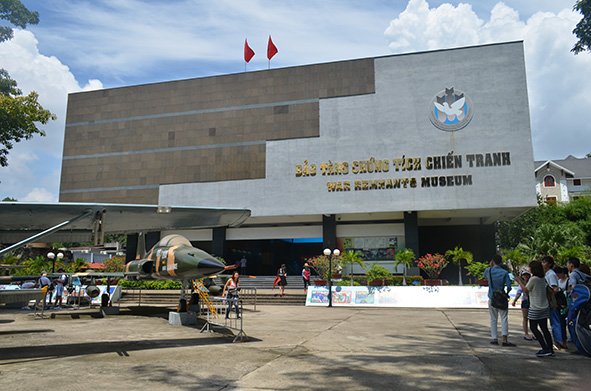Saigonese often go to cafés, theaters, cinemas or tourist destinations when they have free time on weekends or holidays while many visitors to HCMC opt for visits to museums to get an insight into culture and history of the country and to entertain themselves with contemporary arts on display at some of the museums and the greenery around these buildings.

War Remnants Museum
Hereafter are some of the museums in HCMC for visitors to learn about almost everything about Viet Nam within a day if they do not have much time in the city.
War Remnants Museum, 28 Vo Van Tan Street in District 3
Opened in 1975, the three-storey museum has eight exhibition rooms and especially a courtyard where tanks, a helicopter, weapons, and other remnants of war are on show. The exhibits are divided into the themes of Historical Truths, Requiem - a war photography collection, Vestiges of War Crimes, Imprisonment System, Viet Nam War and Peace, International Support, and War and Peace depicted via children’s paintings.
More foreigners come to the museum than the other ones in the city as wars in Viet Nam are possibly the first thing in their mind before they arrive in this country.
“As I worked for the U.S military and I was excited to see what happened to Viet Nam during wars, I rushed to the museum right after I arrived in the city for the first time. My heart was painful when it saw the remnants,” said Dana, an American who is a teacher of English in Saudi Arabia.
HCMC Fine Arts Museum, 97 Pho Duc Chinh in District 1
This grand colonial-architecture mansion is a must-see destination for those who are keen on Viet Nam’s arts. The yellow-white museum not only keeps valuable collections of iconic Vietnamese artists but also holds regular exhibitions for both local and international artists.
Thien Hao from the museum said foreigners come there because they admire the contemporary arts of Viet Nam
Historical Museum, 2 Nguyen Binh Khiem Street in District 1
Opened in the 1920s, the Indochinese-architecture museum is a venue for lovers of carved Cham sculptures, Buddha images across Asia, ethnic minority costumes, clothing, and household items made in the Nguyen dynasty (1802–1945), and archaeological artifacts unearthed in Sai Gon.
The museum is located next to the Botanical Garden and Zoo and is busy every day. “I took my kids to the museum one day and we were surprised. We have since come back many times, and my kids and I have learned so much about our history,” said Nguyen Bac Son, a citizen in HCMC.
Southern Women Museum, 202 Vo Thi Sau in District 3
The museum provides visitors with lessons about traditional Vietnamese women who are not only good at home but also contribute much to protecting, preserving and developing traditions of the country.
On the display are a collection of 350 production tools such as weaving looms, embroidery frames, a mat hand-loom, hand-sewing machine and farming tools, a costume collection of 600 items accompanied and a jewelry collection of 1,155 items.
Ho Chi Minh Museum, 65 Ly Tu Trong in District 1
Visitors to the museum can find pictures and exhibits related to the fights of locals to protect the city and the nation. There are also images of the General Uprising in the Mau Than Spring (1968) and the historical Ho Chi Minh campaign (1975) to reunite the country.
Of course, there are many more museums to visit in the city. The Museum of Southeast Armed Forces at 247 Hoang Van Thu Street in Tan Binh District is for people to learn more about Viet Nam’s history and Fito Museum, 41 Hoang Du Khuong in District 10 to get a glimpse of traditional Vietnamese medicines dating back to the Stone Age.